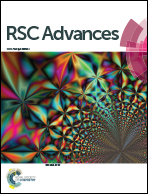Novel nanocellular poly(aryl ether ketone) foams fabricated by controlling the crosslinking degree†
Abstract
Films of poly(aryl ether ketone) containing naphthalene pendants on the side chains (NA-PAEK) with different crosslinking degrees were prepared by thermal crosslinking and foamed using a two-stage batch foaming process. The effects of the crosslinking degree on the sorption of CO2 and foam morphology were investigated. The nucleation rate and foam morphology of the highly elastic polymer were found to depend on the stored elastic energy (SE). Therefore, SE could not be neglected in our system. In addition, the effects of processing parameters such as soaking pressure, soaking time, transferring time, foaming temperature, and foaming time on the foam morphology were investigated. By controlling the crosslinking degree and optimizing the processing parameters, nanocellular poly (aryl ether ketone) foam with a cell size of 86 nm (±11 nm) was successfully fabricated.


 Please wait while we load your content...
Please wait while we load your content...